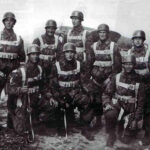Understanding the intricacies of military uniforms can sometimes be complex, especially when it comes to insignia and authorized wear. The US Marine Corps Class A uniform is distinct and recognizable, adhering to its own set of regulations. However, a unique situation arises when considering if and when a US Army soldier might be seen wearing a patch associated with the Marine Corps. This article delves into the specific circumstances under which a US Army personnel member is authorized to display a US Marine Corps shoulder sleeve insignia.
Former Wartime Service with the USMC
One instance, though less common today, involves soldiers who previously served in the Marine Corps during a period when the USMC authorized shoulder patches. Historically, the Marine Corps did utilize shoulder patches, primarily during World War II. If a soldier transitioned from the Marine Corps to the Army and had wartime service with the Marines during that era, they might be authorized to wear the Shoulder Sleeve Insignia – Former Wartime Service (SSI-FWTS), often referred to as a “combat patch,” of their former Marine unit. It’s crucial to note that this is contingent on the Marine Corps authorizing shoulder patches at the time of their service. Given that the Marine Corps discontinued shoulder patches after WWII, this scenario would apply to veterans of that conflict who subsequently served in the Army.
Alt text: A US Army soldier in full uniform standing in Kuwait, illustrating the typical appearance of Army service dress.
Subordination Under USMC Command in Combat
The more prevalent scenario occurs when US Army units are placed under the command of a US Marine Corps division during combat operations. This inter-service cooperation has been observed, notably during the Iraq War. While less documented in Afghanistan, the practice of Army elements serving under Marine command in combat zones has led to a specific uniform authorization. US Army personnel serving in such a capacity are authorized to wear the SSI-FWTS of the Marine Corps command they were subordinated to.
This authorization was notably observed during Operation Iraqi Freedom. Personnel deploying through hubs like Camp Doha in Kuwait reported seeing redeploying soldiers wearing the 2nd Marine Division patches. This practice is codified in regulations like AR 670-1, which outlines uniform and insignia wear for Army personnel, confirming the legitimacy of this seemingly unusual allowance.
Alt text: Official emblem of the US Marine Corps Forces, Pacific, representing a major command within the USMC.
An Incongruous Uniform Regulation
Interestingly, the regulation presents a peculiar situation: a Marine who served in a combat zone and later transferred to the Army would not be authorized to wear their Marine division SSI in their Army uniform, because Marines themselves were not authorized to wear it. Yet, Army personnel under Marine command are granted this privilege. This creates a seemingly paradoxical rule where an insignia of one service, not authorized for wear by its own members in certain contexts, becomes authorized for wear by members of a different service under specific conditions.
This rule, while perhaps unconventional, highlights the unique instances of inter-service collaboration in combat environments and the corresponding adaptations in uniform regulations to acknowledge such joint operations. It serves as a distinctive example of how military uniform policies can reflect the realities of operational deployments and inter-service dynamics.

